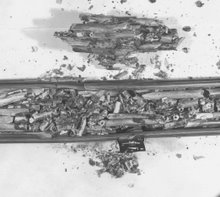Press Release 08-117 Radicals Shake Up Molecules in a Tug o' War
An unexcited deuterium molecule, before being tugged into vibration by a hydrogen atom. Credit and Larger Version
July 3, 2008
View a video representing a collision between a molecule of deuterium and a radical hydrogen atom.
Until now, it was commonly thought that colliding molecules get the shakes as the result of energy transfer solely from the smashing of the molecules, but some new research adds a second means by which colliding molecules become vibrationally excited--it is being called the "Tug o' War Mechanism."
The new experiment, transforming the textbook story, was performed in the lab of Richard Zare, chair of the Department of Chemistry at Stanford University. This work on energy transferring, or inelastic, collisions is featured in the July 3, 2008 issue of the journal Nature.
"How energy transfer occurs in molecular collisions is a topic of deep interest to chemists, for energy transfer is often the precursor to chemical transformations," Zare said. "This is the reason why I regard finding a new mechanism for energizing molecules through collisions to be of such potential importance."
"The work by Zare and his colleagues shows an interesting and unexpected result," shared Charles Pibel, director of the Physical Chemistry Program at the National Science Foundation (NSF). "The conventional wisdom had been that most collisions between molecules excite vibrational motion through a hard impact, like a piano's hammer striking a string."
But instead of molecules impacting and deflecting backwards, the Tug o' War Mechanism stretches the molecule and then releases it, starting the molecule rattling. The effect is "more like a violinist, plucking a string, pizzicato." In the collisions studied by the Zare group, a lone hydrogen atom tugs on one end of a deuterium molecule and lets go, exciting the molecular deuterium into vibration.
More generally, the Tug o' War Mechanism comes into play when a certain type of unstable species, a free radical, looms down a path for collision with another molecule. Because free radicals lack a properly balanced shell of electrons, they are more susceptible to the mechanism than other types of atoms or molecules.
Sometimes a collision between a free radical and another molecule rips apart chemical bonds and atoms are exchanged amongst the colliding partners--that is, a chemical reaction takes place. However, other times when free radicals approach other molecules, this Tug o' War Mechanism stretches the molecule without breaking the bonds.
In this way, free radicals act like renegades attempting to steal atoms from their parent molecule by tugging them away. But if a collision is not at the right angle, the radical might not be able to break the bonds of the molecule. It releases its hold on the nearest atom, or atoms, and then departs. The frustrated, or unsuccessful, chemical reaction nevertheless imparts some energy on the victim of the free radical attack. It is this energy that sets the molecule off dancing with a new vibrational pattern.
The research, funded by NSF, was led by Noah T. Goldberg at Stanford University and Stuart J. Greaves at the University of Bristol, U.K., and included Zare, Jianyang Zhang and Daniel J. Miller, all from Stanford University, and Eckart Wrede from the University of Durham, U.K.
Award Abstract #0650414 State-to-State Reaction Dynamics
NSF Org:
CHE Division of Chemistry
Initial Amendment Date:
August 14, 2007
Latest Amendment Date:
June 23, 2008
Award Number:
0650414
Award Instrument:
Continuing grant
Program Manager:
Charles D. Pibel CHE Division of ChemistryMPS Directorate for Mathematical & Physical Sciences
Start Date:
September 1, 2007
Expires:
August 31, 2009 (Estimated)
Awarded Amount to Date:
$540842
Investigator(s):
Richard Zare zare@stanford.edu(Principal Investigator)
Sponsor:
Stanford University 651 Serra Street, Room 220 STANFORD, CA 94305 650/723-2300
NSF Program(s):
SPECTROSCOPY
Field Application(s):
Program Reference Code(s):
OTHR,0000
Program Element Code(s):
1962
ABSTRACTIn this award, funded by the Experimental Physical Chemistry Program of the Chemistry Division Prof. Richard N. Zare of Stanford University and his postdoctoral and graduate student colleagues will examine chemical reactions with the most exquisite detail. Prof. Zare and his group will continue their studies of state-to-state reaction dynamics in fundamental chemical systems, seeking to identify how chemical reactions depend upon the precise distribution of molecular excitation within the reacting partners, and to probe the deposition of the energy into the chemical products. The ultimate goal of these studies is to understand, at the most fundamental level, the driving forces for chemical reactions. The centerpiece of this work will be the study of the reaction and inelastic scattering of a hydrogen atom with molecular hydrogen. Prof. Zare will continue to serve as a mentor to a diverse group of young scientists, and will continue in his wide ranging efforts at educating the public about the importance of science. In this regard, Prof. Zare's service as a host of WONDERFEST is emblematic; WONDERFEST is a Bay Area celebration of science and attracts over one thousand people a year to learn about and debate upon current topics in science.
Saturday, July 5, 2008
Subscribe to:
Post Comments (Atom)

No comments:
Post a Comment